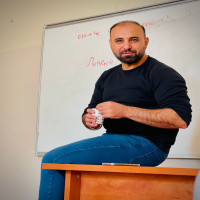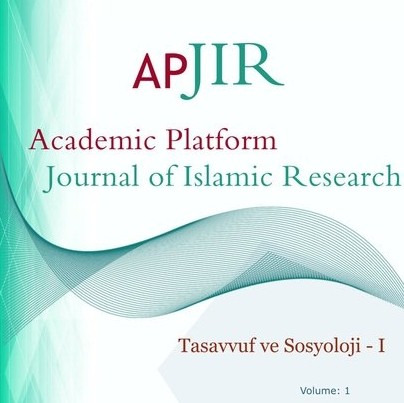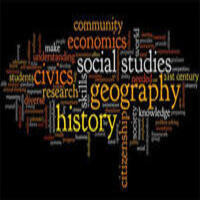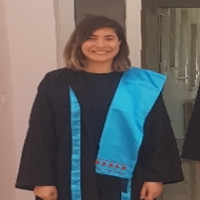Research Articles
Review Article
Book Reviews
Issue Reviewers












 0000-0001-9085-3426
0000-0001-9085-3426


Aim & Scope
1. Eurasian Journal of Humanities Research is a scientific, international refereed journal published twice a year (July-December) by Karabük University Faculty of Letters.
2. Eurasian Journal of Humanities Research includes scientific articles that are based on research that will cover the subject area of Social Sciences and Humanities, will provide original contributions to the field, and have not been published anywhere before. The legal responsibility of the articles belongs to the authors. The manuscript is accepted to be submitted to the Eurasian Journal of Humanities Research without charge. No fee is charged for the publication of the articles.
3. The Editorial Board of the Journal evaluates whether the articles to be published in the Journal of Eurasian Humanities Research are scientifically and technically suitable for publication. The eligible manuscripts are sent to three referees from different universities who are experts in their fields for evaluation. Manuscripts that receive “approval” from at least two referees can be published in the Journal of Eurasian Humanities Research.
4. Manuscripts that are not deemed appropriate for publication by the Editorial Board or the Referee Committee are not returned to their authors.
5. The legal, scientific and ethical responsibility of the articles published in Eurasian Journal of Humanities Research belongs to the authors.
6. Articles published in the Journal of Eurasian Humanities Research can be quoted - to a limited extent - by citing the source.
7. The publication language of the Journal of Eurasian Humanities Research is Turkish. However, articles can be published in English, Arabic, German, French, French, Russian, Persian, Arabic, German, French, Russian and Persian languages, provided that they do not exceed 30% of the published articles. Articles submitted in foreign languages should be sent together with their Turkish versions.
The Eurasian Journal of Humanities Research includes scientific articles that are based on research that will cover the subject area of Social Sciences and Humanities, will provide original contributions to the field, and have not been published anywhere before.
Author Guidelines
Click here for the manuscript template.
Click here to access the Copyright Agreement form template.
1. The Turkish Title of the study should be written in 14-point font in “Adobe Garamond Pro” (font style) with the first letter of each word capitalized (except conjunctions) and maximum 15 words should be bold.
2. The English Title of the study should be written with the first letter of each word capitalized (excluding conjunctions) and in “Adobe Garamond Pro” font in 12-point font and no more than 15 words should be bold.
3. The author information section should be left blank. “do not write names!”
4. Abstract: In this section, the purpose of the study, the material(s) and method(s) used, important findings and the result(s) obtained should be clearly and concisely stated. The text should be written in “Adobe Garamond Pro” font, 10 pt. and single-spaced in accordance with Turkish spelling rules. There should be no paragraphs. The text to be included in this section should be between 100-200 words.
5. Do not make changes in the sections containing author names and addresses, date information and corresponding author.
6. Keywords: In this section, please include at least 3 and at most 5 Turkish keywords describing your study, separated by commas, in “Adobe Garamond Pro” font in 10 pt.
7. Abstract: In this section, the purpose of the study, the material(s) and method(s) used, significant findings and the conclusion(s) obtained should be clearly and concisely stated. The text should be written in “Adobe Garamond Pro” font, 10 pt. and single-spaced in accordance with English spelling rules. There should be no paragraphs. The text to be included in this section should be between 100-200 words.
8. Keywords: In this section, please include at least 3 and at most 5 English keywords describing your study, separated by commas, in “Adobe Garamond Pro” font, 10 pt.
9. Articles should include the titles Introduction, Conclusion and Discussion. Method, Results and Recommendations should be added according to the field.
10. The text should be written in accordance with the Turkish spelling rules in “Adobe Garamond Pro” font, 11 pt, 6 pt before, 6 pt after, single line spacing. Page dimensions: Top: 2.00, Left: 2.00, Bottom: 2.00, Right: 2,00.
11. Introduction (Main headings should be centered. Only the first letter of the words should be capitalized).
12. After pasting the full text of your article on the template, make sure that the fonts are in accordance with the styles on the template. Articles whose fonts do not match the styles on the template will be sent back to you for editing. Be careful not to leave any spaces in the text with the “enter” key.
13. Subheading 1 (Subheadings should be left justified. Only the first letter of the words should be capitalized).
14. Footnotes to be used in articles should be written in “Adobe Garamond Pro” font, 8 pt. and single-spaced. Do not write references in footnotes. Only briefly introduce terms or concepts specific to your field in one sentence.
15. To apply the formatting styles in the article, select the formatting style of the relevant section for each text you transfer to the template. Check the font size and type. It is not enough to transfer only the text.
16. References: References should be organized according to APA 7 bibliography system. The bibliography section should start on a new page.
17. Your article should not exceed 25 pages (including references) (Note: Appendices are not included in the page count).
EXAMPLES OF IN-TEXT REFERENCE CITATION
Single-author references in the text should be cited as follows.
(Dwyer, 1993) or Dwyer (1993)
In references to sources with two authors in the text, the symbol “&” should be used instead of the conjunction “and” in parentheses.
Whether the text is written in English or Turkish, the conjunction “&” should be used in parenthetical references. (Turgut & Baykul, 2012) or Turgut and Baykul (2012) [if the text is in Turkish], Turgut and Baykul (2012) [if the text is in English]
In each citation to references with more than two authors in the text, the last name of the first author is given and the other authors should be abbreviated as “vd.” in Turkish texts and “et al.” in English texts.
(Hair vd., 2009) [if the text is in Turkish], (Hair et al., 2009) [if the text is in English] or Hair vd. (2009) [if the text is in Turkish], Hair et al. (2009) [if the text is in English]
Multiple references given in parentheses at the end of a sentence in the text should be listed in alphabetical order and separated by “;” (semicolon).
(Fraenkel et al., 2011; He, 2011; Saylı, 2015) [If the text is in Turkish]
(Fraenkel et al., 2011; He, 2011; Saylı, 2015) [Text in English]
The use of quotations in the text should be as follows.
(Green & Salkind, 2005, as cited in Can, 2017) / Green and Salkind (2005) word by word ... (as cited in Can, 2017) [if the text is in Turkish]
(Green & Salkind, 2005, as cited in Can, 2017) / Green and Salkind (2005) word by word ... (as cited in Can, 2017)
In-text citations to more than one source by the same author should be cited as follows.
(Gwet, 2008, 2016) or Gwet (2008, 2016)
Abbreviations in in-text citation are as follows.
(Millî Eğitim Bakanlığı [MEB], 2019), subsequently cited as MEB (2019) [if the text is in Turkish]
(Ministry of National Education [MoNE], 2019), MoNE (2019) [Text in English]
Sources of the same author from the same year should be cited as follows in in-text citations.
(MoNE, 2017a, 2017b) or MoNE (2017a, 2017b) [if the text is in Turkish]
(MoNE, 2017a, 2017b) or MoNE (2017a, 2017b) [if the text is in English]
In in-text reference citations, if the page information of the source is to be presented, it should be shown as follows.
(Büyüköztürk et al., 2019, p. 184) [if the text is in Turkish], (Büyüköztürk et al., 2019, p. 184) [if the text is in English] or Büyüköztürk et al. (2019, p. 194) [if the text is in Turkish], Büyüköztürk et al.
(Creswell, 2012, p. 341) [Text in Turkish], (Creswell, 2012, p. 341) [Text in English] or Creswell et al. (2012, p. 341) [Text in Turkish], Creswell et al.
In-text citations to a book chapter should include only the last name of the author or authors of the chapter.
(Messick, 1993) or Messick (1993)
Translated texts should be cited as follows. The first date indicates the publication date of the translated text and the second date indicates the publication date of the original text.
(DeVellis, 2012/2014) or DeVellis (2012/2014)
REFERENCES
The first line of all references must be one line space from the first line to the last line. If the articles have a Doi number, it must be included.
Alger, C. (2009). Secondary teachers' conceptual metaphors of teaching and learning: changes over the career span. Teaching and Teacher Education: An International Journal of Research and Studies, 25(5), 743–751. https://doi.org/10.1016/j.tate.2008.10.004
Doğan, M., Nacaroğlu, O., & Ablak, S. (2021). Sivrice depremini yaşamış ortaokul öğrencilerinin depreme ilişkin metaforik algılarının incelenmesi: Malatya ili örneği. Dokuz Eylül Üniversitesi Buca Eğitim Fakültesi Dergisi, 1(51), 384-402. https://doi.org/10.53444/deubefd.885116
Guerrero, M. C. M., & Villamil, O.S. (2002). Metaphorical conceptualizations of ELS teaching and learning. Language Teaching Research, 6(2), 95-120. https://doi.org/10.1191/1362168802lr101oa
Conferences and Symposiums
Çetin, S. & Yalçın, O. (2020, Eylül 16-19). Geniş ölçekli sınavların ölçme ve değerlendirme süreçlerinin görme engelli bireyler açısından incelenmesi [Sözlü bildiri]. Uluslararası Pegem Eğitim Kongresi, Türkiye.
Thissen, D., & Thissen-Roe, A. (2019, July 15-19). Factor score estimation from the perspective of item response theory [Paper presentation]. International Meeting of the Psychometric Society, Santiago de Chile.
Books
Büyüköztürk, Ş., Kılıç Çakmak, E., Akgün, Ö. E., Karadeniz, Ş. & Demirel, F. (2019). Bilimsel araştırma yöntemleri (26. baskı). Pegem Akademi.
Atalay, İ. (2011). Türkiye coğrafyası ve jeopolitiği. Meta Basım Matbaacılık.
Fraenkel, R. J., Wallen, E. N., & Hyun, H. H. (2011). How to design and evaluate research in education (8th ed.). McGraw-Hill.
Turgut, M. F. & Baykul, Y. (2012). Eğitimde ölçme ve değerlendirme (4. baskı). Pegem Akademi.
Editorial Book
Atılgan, H. (Ed.). (2017). Eğitimde ölçme ve değerlendirme (10. baskı). Anı Yayıncılık.
Thorndike, R. M., & Thorndike-Christ, T. (Eds.). (2014). Measurement and evaluation in pschology and education (8th ed.). Pearson.
Encyclopedia Article
Soyadı, A. (2023). Madde başlığı. İçinde Ansiklopedi adı (C. 1, s. 23). Milli Eğitim Basımevi [MEB].
Çeviri Kitap
DeVellis, R. F. (2014). Ölçek geliştirme kuram ve uygulamalar (Çev. T. Totan, 3. baskı). Nobel Yayıncılık. (Orijinal çalışma 2012 yılında yayımlandı.)
Editorial Book Section
Kılcan, B. (2017). Eğitim bilimlerinde metaforların veri toplama aracı olarak kullanılması, örnek bir uygulama. B. Kılcan (Ed.), Metafor eğitimde metaforik çalışmalar için bir uygulama rehberi içinde, (ss. 93-112). Pegem Akademi.
Messick, S. (1993). Trait equivalence as construct validity of score interpretation across multiple methods of measurement. In R. E. Bennett & W. C. Ward (Eds.), Construction versus choice in cognitive measurement: Issues in constructed-response, performance testing, and portfolio assessment (pp. 61-73). Lawrence Erlbaum Associates, Inc.
Report
Dwyer, E. E. (1993). Attitude scale construction: A review of the literature (Report No. ED359201). ERIC. https://eric.ed.gov/?id=ED359201
Millî Eğitim Bakanlığı (MEB). (2017). Akademik becerilerin izlenmesi ve değerlendirilmesi (ABİDE) 2016 8. sınıflar raporu. https://odsgm.meb.gov.tr/meb_iys_dosyalar/2017_11/30114819_iY-web-v6.pdf
Unpublished Thesis
Bıkmaz, Ö. (2011). Üst düzey zihinsel özelliklerin ölçülmesinde puanlayıcılar arası güvenirlik belirleme tekniklerinin karşılaştırılması [Yüksek lisans tezi]. Hacettepe Üniversitesi, Ankara.
Spence, P. D. (1996). The effect of multidimensionality on unidimensional equating with item response theory [Doctoral dissertation]. University of Florida, USA.
Thesis Published and Accessed from a Database
Ayan, C. (2018). Bilişsel tanı modelinde geleneksel ve bilgisayarlı sınıflamalı test uygulamalarının psikometrik özelliklerinin karşılaştırılması [Doktora tezi, Ankara Üniversitesi]. https://tez.yok.gov.tr/UlusalTezMerkezi/
He, Y. (2011). Evaluating equating properties for mixed-format tests [Doctoral dissertation, University of IOWA]. https://ir.uiowa.edu/etd/981/
Software
R Development Core Team. (2018). R: A language and environment for statistical computing (version 3.5.2) [Computer software]. R Foundation for Statistical Computing.
SAS Instutite. (2015). Statistical analysis software (version 9.4) [Computer software]. SAS Institute.
The APPENDICES section should start on a new page.
Ethical Principles and Publication Policy
Publication Ethics and Publication Policy:
Eurasian Journal of Humanities Research (ABBAD): Karabuk Journal of Turcology adheres to the highest standards in publication ethics and adopts the ethical publishing principles published by the Committee on Publication Ethics (COPE), Directory of Open Access Journals (DOAJ), Open Access Scholarly Publishers Association (OASPA) and World Association of Medical Editors (WAME); for the principles expressed under the title Principles of Transparency and Best Practice in Scholarly Publishing: https://publicationethics.org/resources/guidelines-new/principles-transparency-and-best-practice-scholarly-publishing
The content of the manuscripts submitted to the journal for publication should be compatible with the journal's purpose and scope. The journal prioritizes the publication of original research articles.
General Guidelines:
Papers that have not been previously published or are not currently under review for publication in another journal and are approved by each author are accepted for review. Manuscripts that pass the preliminary evaluation are subjected to the iThenticate plagiarism scanning program. Authors are informed if plagiarism/self-plagiarism is detected. After plagiarism review, eligible manuscripts are evaluated by the Editor for their originality, methodology, importance of the topic addressed in the article, and appropriateness to the scope of the journal. If necessary, the Editors/Editor may subject the article to plagiarism checks at various stages of the review or production process. High similarity rates may result in an article being rejected before or even after acceptance. Depending on the type of paper, this is expected to be less than 15% or 30%. Plagiarism, duplication, false authorship/confessed authorship, research/data fabrication, article slicing, slicing and dicing, copyright infringement and concealment of conflict of interest are considered unethical behavior. All articles that do not comply with accepted ethical standards are removed from publication. This includes articles containing possible irregularities and non-compliances detected after publication.
Abstracts presented at scientific meetings are accepted as references provided that they are mentioned in the article. If the submitted manuscript complies with the formal guidelines, the editor submits the manuscript to the evaluation of two referees from Turkey and/or abroad; the editor approves the publication of the article after the changes deemed necessary by the referees are made by the authors.
After the manuscript is submitted to the Journal for publication, none of the authors' names can be deleted from the list of authors without the written permission of all authors, and no new name can be added as an author and the order of authors cannot be changed.
Articles, pictures and photographs that are not accepted for publication will not be returned to the authors. All rights of the published articles and pictures belong to Eurasian Journal of Humanities Research (ABBAD). By submitting an article to the journal, the author agrees in advance that he/she gives the copyrights to the Eurasian Journal of Humanities Research (ABBAD) without demanding a royalty fee.
Authors' Responsibility:
It is the responsibility of the authors to ensure that the manuscripts comply with scientific and ethical rules. The author must ensure that the article is original, has not been previously published elsewhere and is not under consideration for publication elsewhere, in another language. Applicable copyright laws and treaties should be observed. Copyrighted material (e.g. tables, figures or large quotations) should be used with appropriate permission and acknowledgment. The work of other authors, contributors or sources cited should be used appropriately and cited in the references.
All authors must have made a direct academic and scientific contribution to the submitted manuscript, where an “author” is considered to be someone who has made a significant contribution to the conceptualization and design of the published research, the acquisition, analysis or interpretation of data, and who has been involved in writing the manuscript or in critically reviewing it for content. Other conditions for being an author are planning or executing and/or revising the work in the article. Funding, data collection or general supervisor/advisor of the research group alone does not confer authorship. All individuals cited as authors must meet all the criteria listed above, and any individual who meets the above criteria may be cited as an author. The order of authors' names should be a joint decision. All authors must indicate the order of authorship on the Copyright Transfer form. By submitting an article to the journal, the author agrees in advance that he/she gives the copyright to Eurasian Journal of Humanities Research (ABBAD) without demanding a royalty fee.
All individuals who do not meet the criteria for authorship but have contributed to the study should be listed in the “acknowledgments/information” section. Examples of these include those who provided only technical support, helped with the writing, or provided only general support, financial and material support.
All authors should declare any financial relationships, conflicts of interest and competition of interest that have the potential to influence the results of the research or the scientific evaluation. If an author identifies a significant error or inaccuracy in his/her published manuscript, he/she has the responsibility to immediately contact and cooperate with the editor for correction or retraction.
Editor and Referee Responsibilities and Review Process:
Manuscripts submitted to Eurasian Journal of Humanities Research (ABBAD) are subjected to a double-blind refereeing system. After a plagiarism check, eligible manuscripts are evaluated by the editor-in-chief for originality, methodology, importance of the topic covered, and compatibility with the scope of the journal. The Editor-in-Chief ensures that the manuscripts undergo double blind review in a fair manner, and if the manuscript meets the formal guidelines, he/she submits the manuscript to the evaluation of at least two referees from Turkey and/or abroad, and if the referees deem it necessary, they approve the publication of the manuscript after the requested changes are made by the authors.
Editors/Editor evaluate the articles objectively in accordance with scientific and ethical rules. They ensure that the articles submitted for publication undergo double blind peer review in a fair manner. They guarantee that all information regarding the submitted articles will remain confidential until the article is published. Editors/Editor are responsible for the content and overall quality of the publication. They should publish error pages or make corrections when necessary.
The Editor-in-Chief does not allow conflicts of interest between authors, editors and reviewers. He/she has full authority to appoint reviewers and is responsible for making the final decision on the articles to be published in the Journal.
Reviewers evaluate the articles objectively in accordance with scientific and ethical rules. They should not have any conflicts of interest with the authors and/or financial supporters of the research. They must reach an impartial judgment at the end of their evaluation.
Reviewers should identify published studies on the subject that are not cited by the authors. They should ensure that all information about submitted manuscripts is kept confidential and report to the editor if they discover any copyright infringement or plagiarism on the part of the author. If the referee does not feel qualified to review the manuscript or is unlikely to be able to provide timely feedback, he/she should inform the editor and ask him/her to exclude him/her from the review process.
During the review process, the editor should make it clear to reviewers that manuscripts submitted for review are the private property of the authors and that this is a privileged communication. Reviewers and editorial board members may not discuss articles with other individuals. Reviewers are not allowed to make copies of the manuscripts for themselves and may not give the manuscripts to anyone else without the editor's permission. Reviewers' revisions may not be published or disclosed without the permission of the author and the editor. Care must be taken to keep the identity of the reviewers confidential. In some cases, with the decision of the editor, the comments of the relevant reviewers on the article can be sent to other reviewers who have reviewed the same article, so that the reviewers can be enlightened in this process.
Research Ethics:
The journal upholds the highest standards of research ethics and adopts the international principles of research ethics defined below. It is the responsibility of the authors to ensure that manuscripts comply with ethical guidelines.
- The principles of integrity, quality and transparency must be ensured in the design, review of the design and conduct of the research.
- The research team and participants should be fully informed about the purpose of the research, its methods and possible anticipated uses, and the requirements and risks, if any, of participation in the research.
- Confidentiality of information provided by research participants and confidentiality of respondents must be ensured. The research should be designed to protect the autonomy and dignity of the participants.
- Research participants should take part in the research voluntarily and should not be under any coercion.
- Harm to participants should be avoided. The research should be planned in a way that does not put participants at risk.
- Research independence must be clear and explicit; any conflict of interest must be disclosed.
- In experimental studies with human subjects, the written informed consent of the participants who decide to participate in the research must be obtained. - Consent must be obtained from the legal guardian of children and those under guardianship or with a confirmed mental illness.
- If the study will be conducted in any institution or organization, approval must be obtained from this institution or organization that the study will be conducted.
- In studies with a human element, it should be stated in the “method” section that “informed consent” has been obtained from the participants and ethics committee approval has been obtained from the institution where the study is conducted.
Open Access Policy:
Eurasian Humanities Research (ABBAD) provides all content free of charge on the internet to the reader or the organization to which the reader belongs. Readers can read, download, copy, search and link to the full text of journal articles without permission from the publisher or author, except for commercial purposes. This is in line with the BOAI definition of open access.
Price Policy
The authors are legally responsible for the articles. The manuscript is accepted to be submitted to the Eurasian Journal of Humanities Research without charge. No fee is charged for the publication of the papers.

